
A Windows Intéző az átjáró a grafikus felhasználói felülethez (GUI), amellyel a Windows operációs rendszerben navigálhatunk. Ez a felhasználói shell, amely lehetővé teszi az asztal, a Fájlkezelő, a Start menü és a tálcák felfedezését, valamint sok más hozzá kapcsolódó dolgot. Bizonyos helyzetekben előfordulhat, hogy újra kell indítania, például ha egy vagy több eleme meghibásodik, vagy ha a képernyő lefagy.
A Windows 11 rendszerrel a Microsoft nagymértékben megtámasztotta a Windows Intézőt, és „központosította” az egész élményt. De az újraindítás módjai továbbra is ugyanazok. Itt megnézzük, hogyan indítható újra a Windows Intéző, és mi történik ilyenkor.
Tartalom
Mi történik a Windows Intéző újraindításakor (és mikor kell ezt megtenni)?
A Windows Intéző újraindítása olyan, mint bármely más alkalmazás újraindítása – leállítja a felhasználói héjat, majd újraindítja. Ez azt jelenti, hogy az összes tőle függő folyamat, mint például az asztal, a tálca, a Start menü és a Fájlböngésző újra betöltődik, ezáltal kijavítva az esetlegesen felmerülő apró problémákat. Ha a rendszer lefagy vagy késik, gyakran elegendő a Windows Intéző újraindítása a probléma megoldásához.
Jó tudni, hogyan kell ezt megtenni, mivel ez az egyik leggyorsabb módja a akadozó asztali élmény vagy a nem reagáló tálca kijavításának. A Windows Intézőnek újra kell indulnia, amikor módosítja a HKEY_CURRENT_USER beállításjegyzéket, ami egy másik ok, hogy megtudja, hogyan kell ezt megtenni.
A Windows Intézőt egyszerűen leállíthatja anélkül, hogy újraindítaná. Ha így tesz, akkor egy üres asztal marad a tálcán vagy a Start menü nélkül. A fájlkezelő sem lesz elérhető. De újraindítani egy ciki.
Kapcsolódó: A Windows 11 visszaállítása
Indítsa újra a File Explorert a Windows 11 rendszeren
Íme az összes mód, amellyel újraindíthatja a Windows Intézőt Windows 11 rendszeren. Vegye figyelembe, hogy bár az ebben az útmutatóban látható vizuális hivatkozások a Windows 11 rendszerre vonatkoznak, ezek a módszerek a Windows 10 rendszeren is működnek.
01. módszer: Feladatkezelő használata
Először nyissa meg a Feladatkezelőt a gomb Ctrl + Shift + Escegyidejű megnyomásával . Alternatív megoldásként egyszerűen kattintson a jobb gombbal a Start menüre, és válassza a Feladatkezelő lehetőséget .
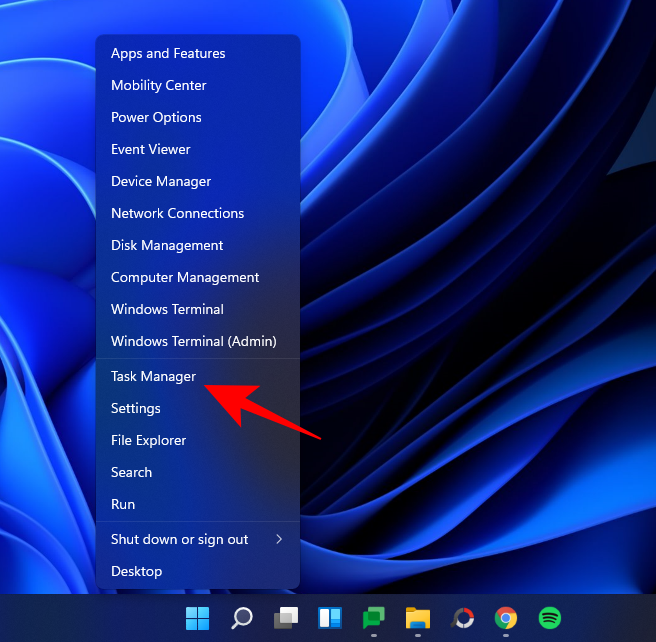
Kattintson a További részletek elemre, ha a Feladatkezelő miniatűr formában nyílik meg.
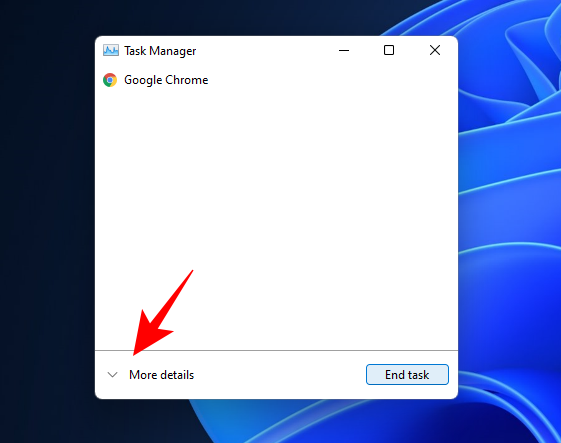
Görgessen végig a Folyamatokban, és keresse meg a Windows Intézőt. Jelölje ki, majd kattintson az Újraindítás gombra a jobb alsó sarokban.

A képernyő vizuális elemei egy pillanatra eltűnnek, majd visszatérnek. Ez azt jelenti, hogy a Windows Intéző bezárása és újraindítása sikeresen megtörtént.
Kapcsolódó: Frissítések eltávolítása Windows 11 rendszeren
02. módszer: Parancssor/Windows Terminál/PowerShell használata
A Windows Intéző újraindításának másik módja egy Windows terminál, például a Parancssor vagy a PowerShell. Példánkban az előbbivel megyünk, de a parancsok mindkettőnél ugyanazok.
Nyomja meg a Start gombot, írja be a cmd (vagy powershell) parancsot , majd kattintson a Futtatás rendszergazdaként lehetőségre .
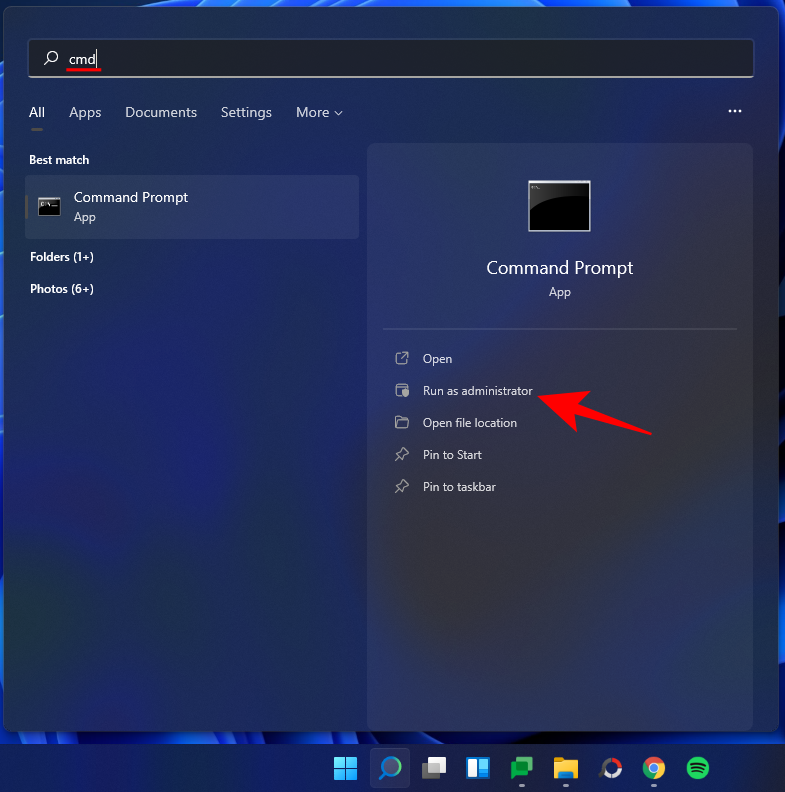
Most írja be a következő parancsot:
taskkill /f /im explorer.exe

Ezután nyomja meg az Enter billentyűt. Amint ezt megteszi, látni fogja, hogy az asztal feketévé válik, és a Start menü és a tálca eltűnik. Ez azt jelenti, hogy sikeresen bezárta a Windows Intézőt. Az újraindításhoz írja be a következő parancsot:
start explorer.exe

Ezután nyomja meg az Enter billentyűt. A vizuális elemek azonnal visszatérnek.
03. módszer: Kötegelt szkript használata
A Windows Intéző újraindításához kötegelt szkriptet is létrehozhat, így a következő alkalommal csak duplán kell rákattintania. Itt van, hogyan:
Kattintson a jobb gombbal az asztalra, és válassza az Új > Szöveges dokumentum menüpontot .
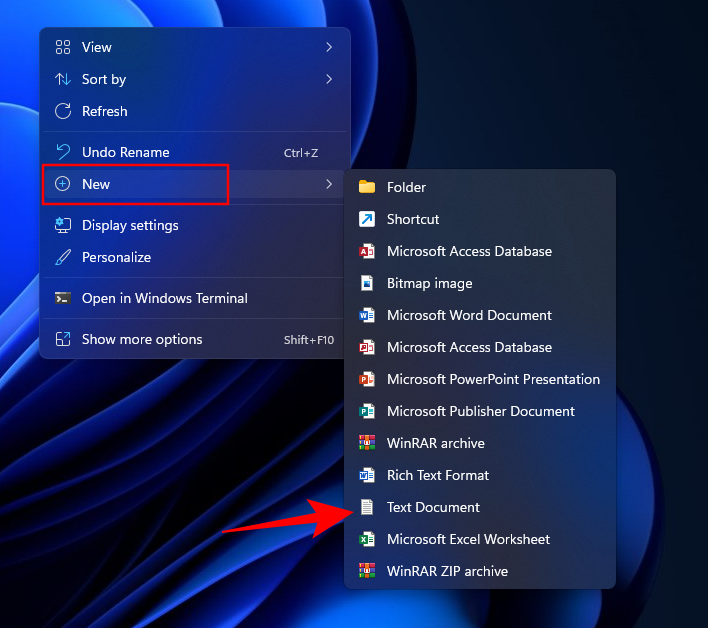
Nyissa meg ezt a Jegyzettömb fájlt, majd írja be a következőket:
@echo off
taskkill /f /im explorer.exe
start explorer.exe
Alternatív megoldásként a fentieket másolhatja és beillesztheti a szöveges dokumentumba.
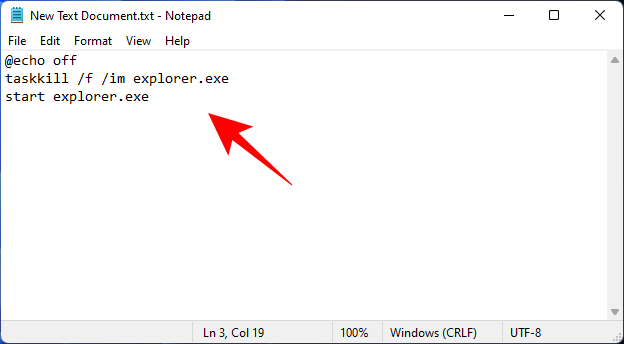
Ezután kattintson a Fájl gombra .
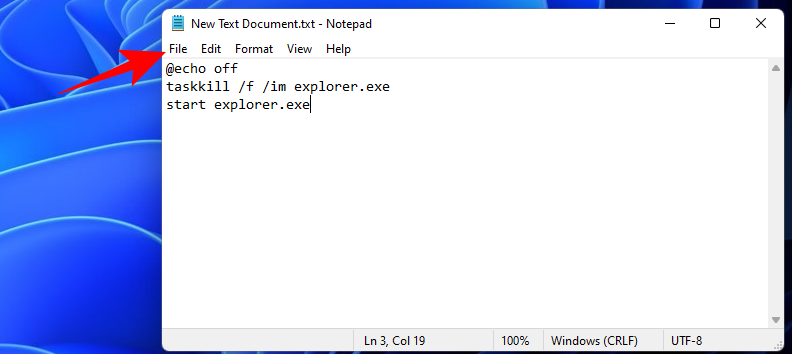
Válassza a Mentés másként lehetőséget .
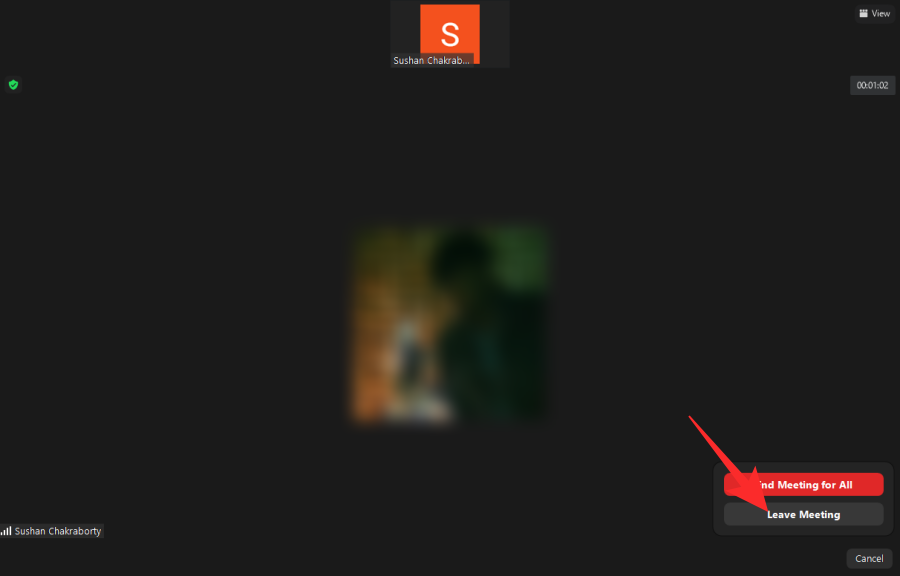
Adjon nevet ennek a fájlnak, és mentse a kiterjesztését .bat néven . Ezután kattintson a Mentés típusként melletti legördülő menüre .
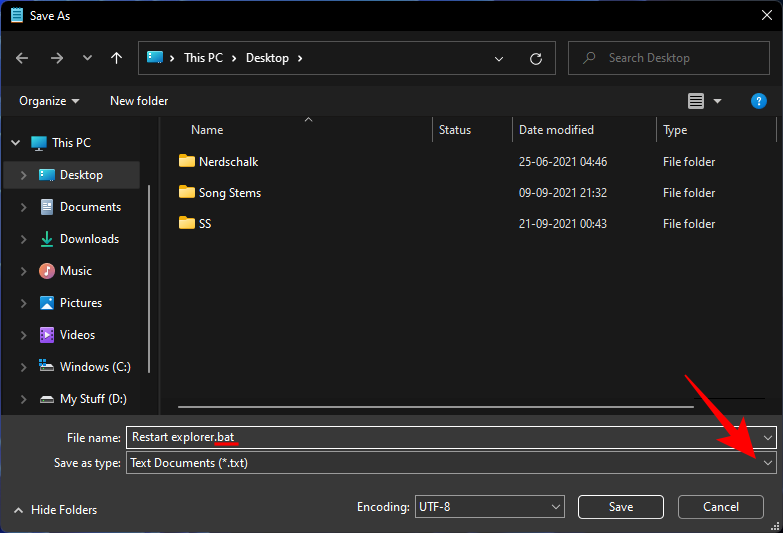
Válassza az Összes fájl lehetőséget .
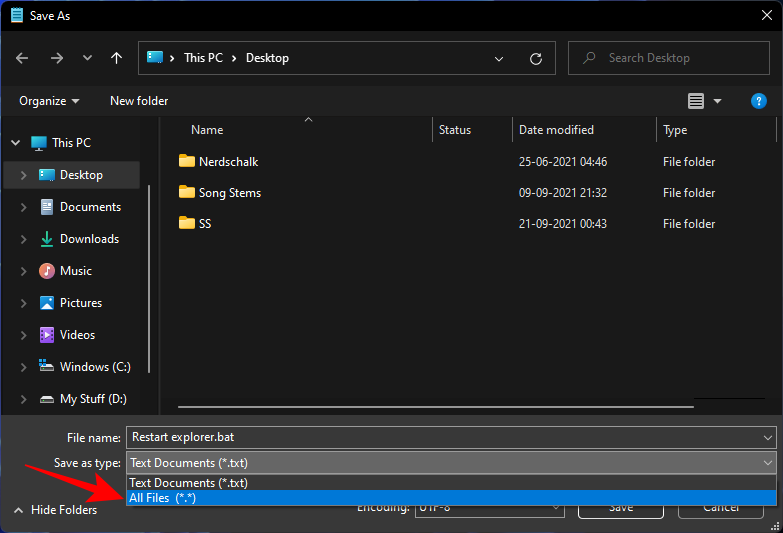
Ezután kattintson a Mentés gombra .
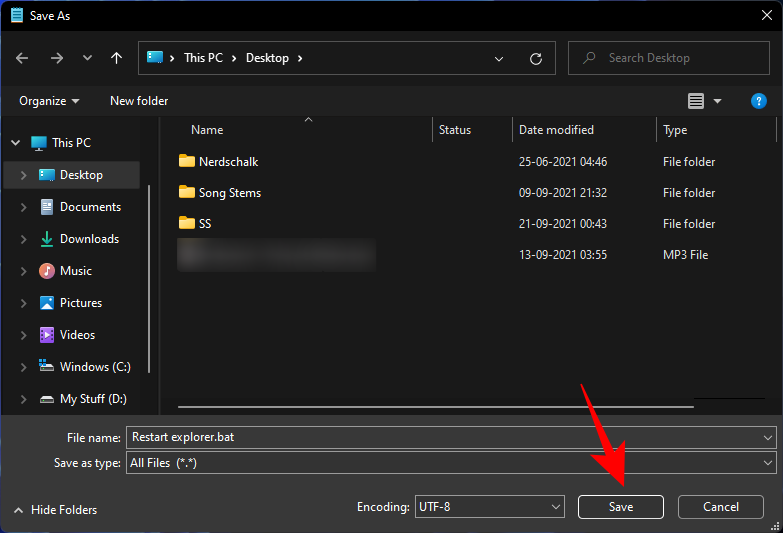
A Windows Intéző újraindításához szükséges kötegfájl most létrejött az asztalon. Amikor legközelebb újra kell indítania a Windows Intézőt, egyszerűen kattintson duplán erre a .bat fájlra.
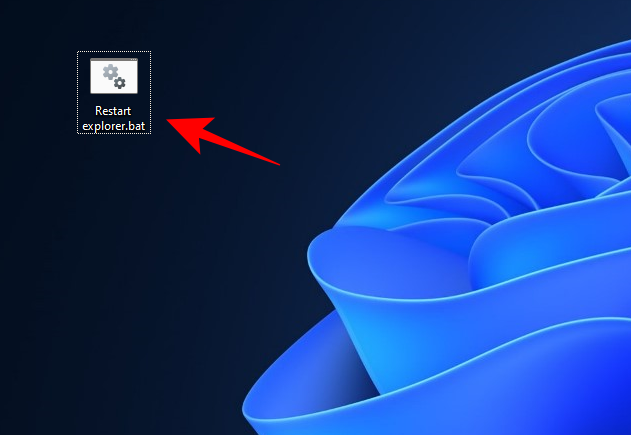
Ha a fent említett módszerek túl bonyolultnak tűnnek, a könnyebb hozzáférés érdekében a helyi menüben felvehet egy lehetőséget a Windows Intéző újraindítására. Ehhez azonban létre kell hoznia egy, a feladathoz tartozó rendszerleíró fájlt. A következőképpen kell eljárni:
Nyisson meg egy szöveges dokumentumot (Jegyzettömb fájlt) az előbbiek szerint. Ezután írja be a következőket:
Windows Registry Editor Version 5.00
[HKEY_CLASSES_ROOT\DesktopBackground\Shell\Restart Explorer]
"icon"="explorer.exe"
"Position"="Bottom"
"SubCommands"=""
[HKEY_CLASSES_ROOT\DesktopBackground\Shell\Restart Explorer\shell\01menu]
"MUIVerb"="Restart Explorer Now"
[HKEY_CLASSES_ROOT\DesktopBackground\Shell\Restart Explorer\shell\01menu\command]
@=hex(2):63,00,6d,00,64,00,2e,00,65,00,78,00,65,00,20,00,2f,00,63,00,20,00,74,\
00,61,00,73,00,6b,00,6b,00,69,00,6c,00,6c,00,20,00,2f,00,66,00,20,00,2f,00,\
69,00,6d,00,20,00,65,00,78,00,70,00,6c,00,6f,00,72,00,65,00,72,00,2e,00,65,\
00,78,00,65,00,20,00,20,00,26,00,20,00,73,00,74,00,61,00,72,00,74,00,20,00,\
65,00,78,00,70,00,6c,00,6f,00,72,00,65,00,72,00,2e,00,65,00,78,00,65,00,00,\
00
[HKEY_CLASSES_ROOT\DesktopBackground\Shell\Restart Explorer\shell\02menu]
"MUIVerb"="Restart Explorer with Pause"
"CommandFlags"=dword:00000020
[HKEY_CLASSES_ROOT\DesktopBackground\Shell\Restart Explorer\shell\02menu\command]
@=hex(2):63,00,6d,00,64,00,2e,00,65,00,78,00,65,00,20,00,2f,00,63,00,20,00,40,\
00,65,00,63,00,68,00,6f,00,20,00,6f,00,66,00,66,00,20,00,26,00,20,00,65,00,\
63,00,68,00,6f,00,2e,00,20,00,26,00,20,00,65,00,63,00,68,00,6f,00,20,00,53,\
00,74,00,6f,00,70,00,70,00,69,00,6e,00,67,00,20,00,65,00,78,00,70,00,6c,00,\
6f,00,72,00,65,00,72,00,2e,00,65,00,78,00,65,00,20,00,70,00,72,00,6f,00,63,\
00,65,00,73,00,73,00,20,00,2e,00,20,00,2e,00,20,00,2e,00,20,00,26,00,20,00,\
65,00,63,00,68,00,6f,00,2e,00,20,00,26,00,20,00,74,00,61,00,73,00,6b,00,6b,\
00,69,00,6c,00,6c,00,20,00,2f,00,66,00,20,00,2f,00,69,00,6d,00,20,00,65,00,\
78,00,70,00,6c,00,6f,00,72,00,65,00,72,00,2e,00,65,00,78,00,65,00,20,00,26,\
00,20,00,65,00,63,00,68,00,6f,00,2e,00,20,00,26,00,20,00,65,00,63,00,68,00,\
6f,00,2e,00,20,00,26,00,20,00,65,00,63,00,68,00,6f,00,20,00,57,00,61,00,69,\
00,74,00,69,00,6e,00,67,00,20,00,74,00,6f,00,20,00,73,00,74,00,61,00,72,00,\
74,00,20,00,65,00,78,00,70,00,6c,00,6f,00,72,00,65,00,72,00,2e,00,65,00,78,\
00,65,00,20,00,70,00,72,00,6f,00,63,00,65,00,73,00,73,00,20,00,77,00,68,00,\
65,00,6e,00,20,00,79,00,6f,00,75,00,20,00,61,00,72,00,65,00,20,00,72,00,65,\
00,61,00,64,00,79,00,20,00,2e,00,20,00,2e,00,20,00,2e,00,20,00,26,00,20,00,\
70,00,61,00,75,00,73,00,65,00,20,00,26,00,26,00,20,00,73,00,74,00,61,00,72,\
00,74,00,20,00,65,00,78,00,70,00,6c,00,6f,00,72,00,65,00,72,00,2e,00,65,00,\
78,00,65,00,20,00,26,00,26,00,20,00,65,00,78,00,69,00,74,00,00,00
A folyamat egyszerűsítéséhez egyszerűen másolja ki a fentieket, és illessze be a jegyzettömb fájlba.
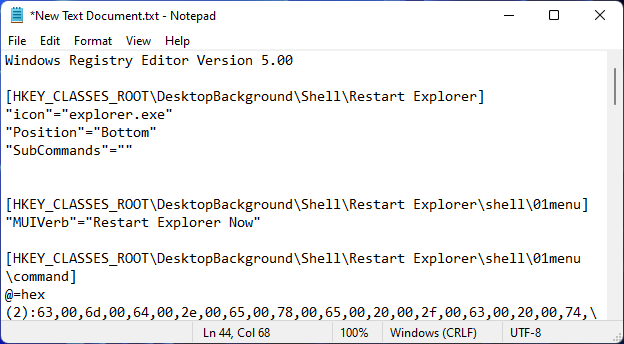
Ezután kattintson a Fájl gombra .

Válassza a Mentés másként lehetőséget .
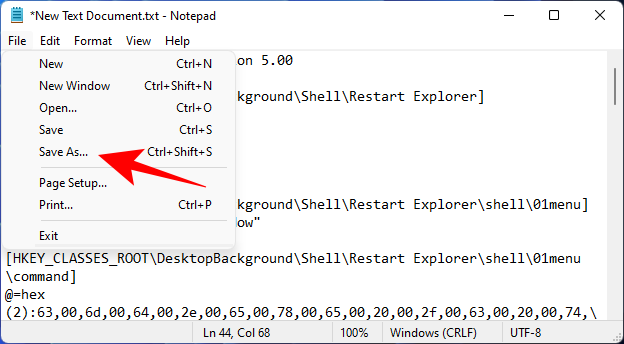
Adjon nevet ennek a fájlnak, és fejezze be .reg karakterrel . Ezután kattintson a Mentés típusként melletti legördülő menüre .
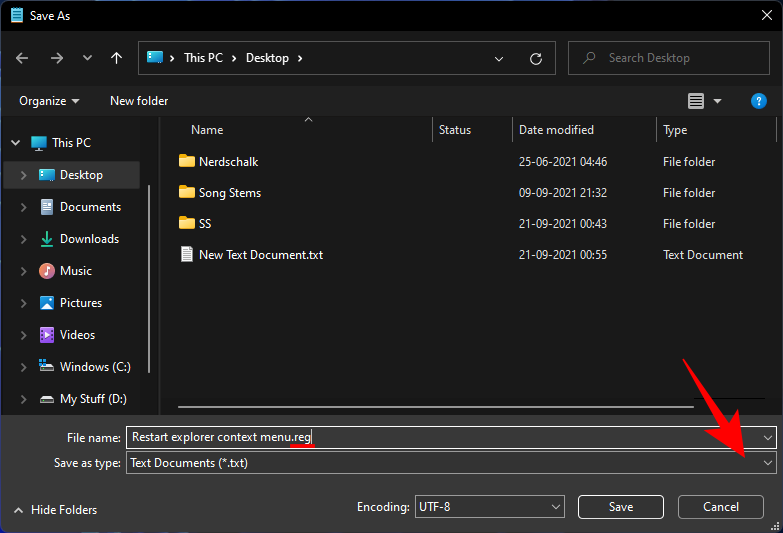
Válassza az Összes fájl lehetőséget .
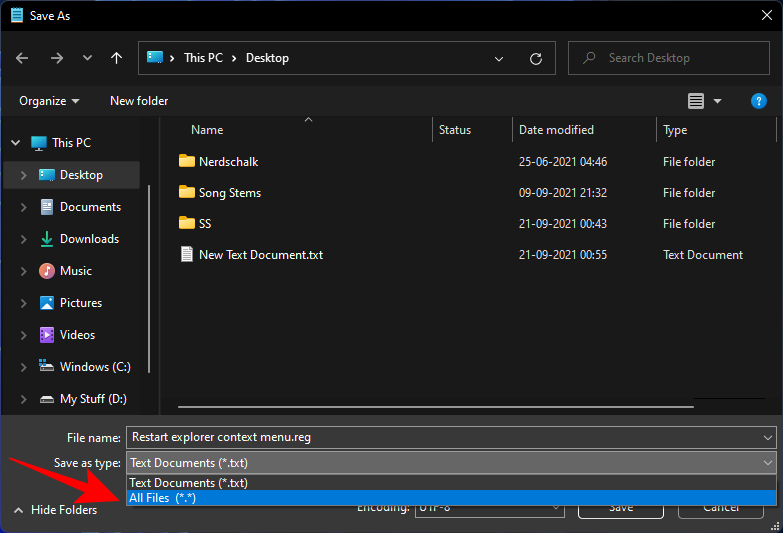
Kattintson a Mentés gombra .

Most kattintson duplán erre az újonnan létrehozott rendszerleíró fájlra.
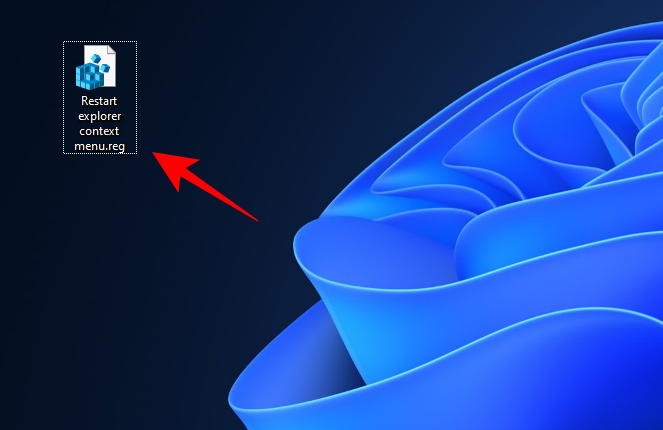
When prompted, click Yes.
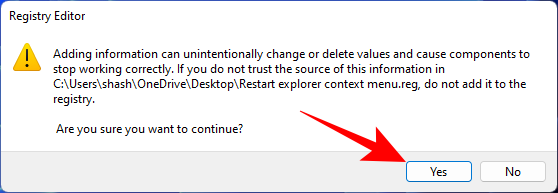
You will now get a confirmation message that the keys and values in this file are successfully added to the registry. Click OK.
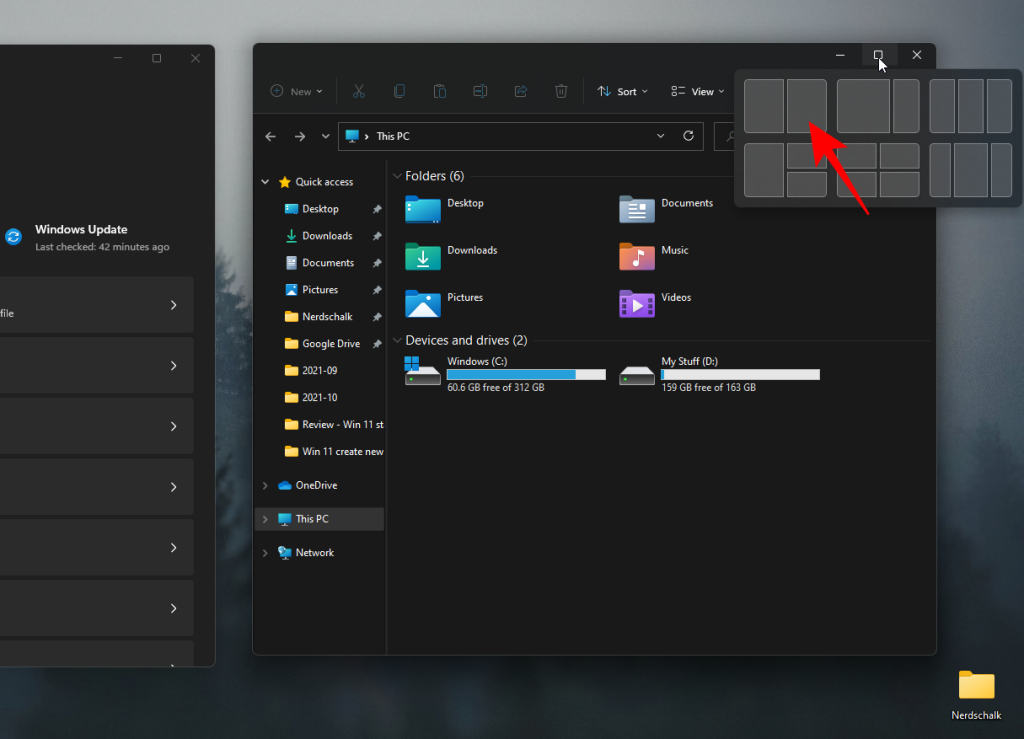
To see the new context menu option to Restart Windows Explorer, right-click on the desktop and select Show more options.
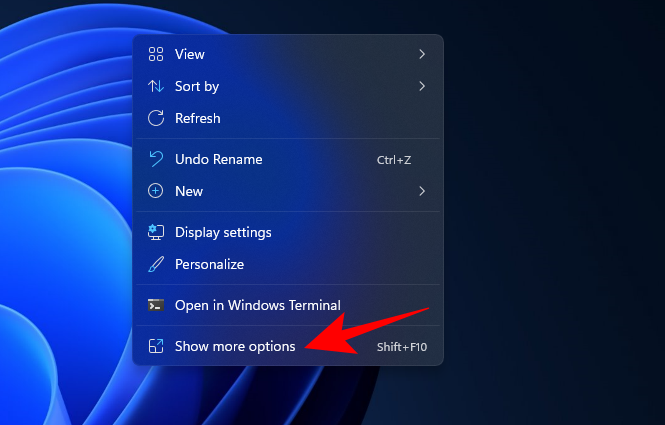
The option to Restart Explorer will be at the bottom. Hover over it to get the options to Restart Explorer Now or Restart Explorer with Pause.
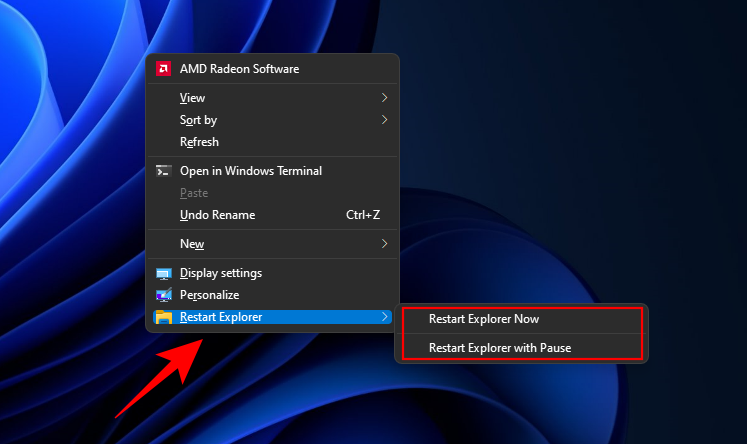
If you’d like to remove this option, create a notepad file and paste the content mentioned below in it.
Windows Registry Editor Version 5.00
[-HKEY_CLASSES_ROOT\DesktopBackground\Shell\Restart Explorer]

Then click on File > Save as.
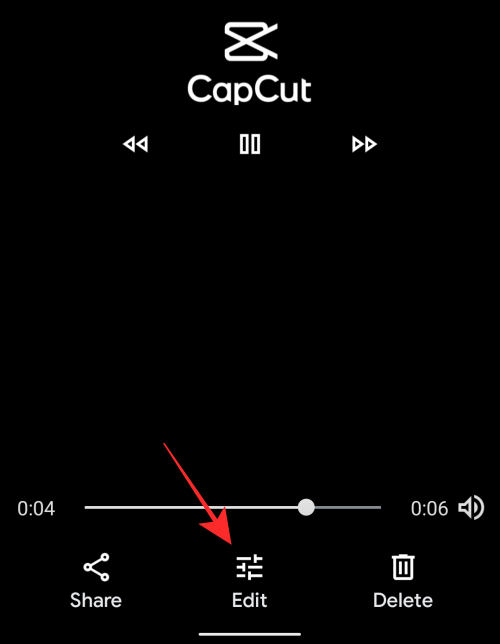
Save the file as a .reg file as we did before and save file type as ‘All files’. Then click Save.
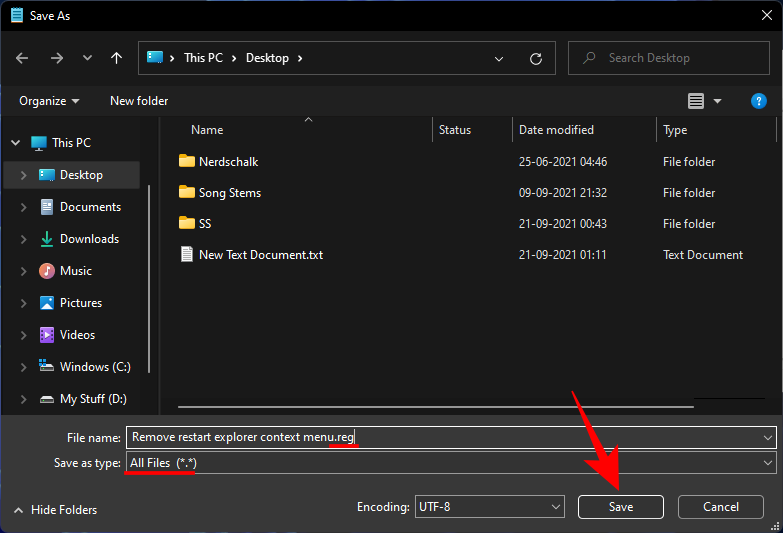
Then double-click this newly created registry file.
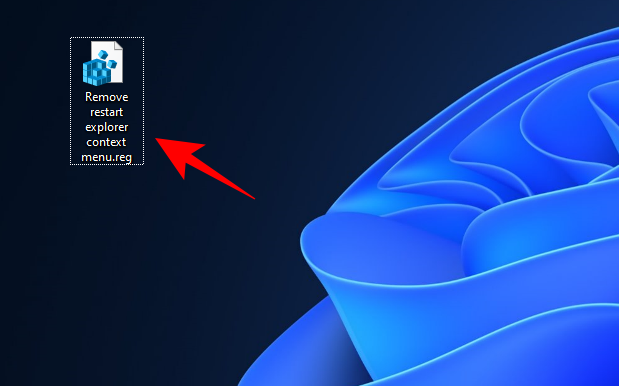
When prompted, click Yes, then click OK.

The option to restart Explorer from the Context Menu will no longer be available.
Fix: Windows Explorer has stopped working
The number one fix to Windows Explorer problems is to restart Windows Explorer using any of the methods mentioned above. This gives all the visual elements of the user shell a soft reboot, allowing them to load the data again and fix any issues that they might be having.
But there are a few other potential fixes that you may want to check out as well. Here they are:
Run SFC scan
Windows Explorer may be encountering issues due to corrupt system files. Here’s how you can check for the same and fix it:
Press Start, type cmd, and click on Run as administrator.

Now type the following command:
sfc /scannow

Then press Enter. This will start the System File Checker scan. You may have to wait a while before the process is finished.
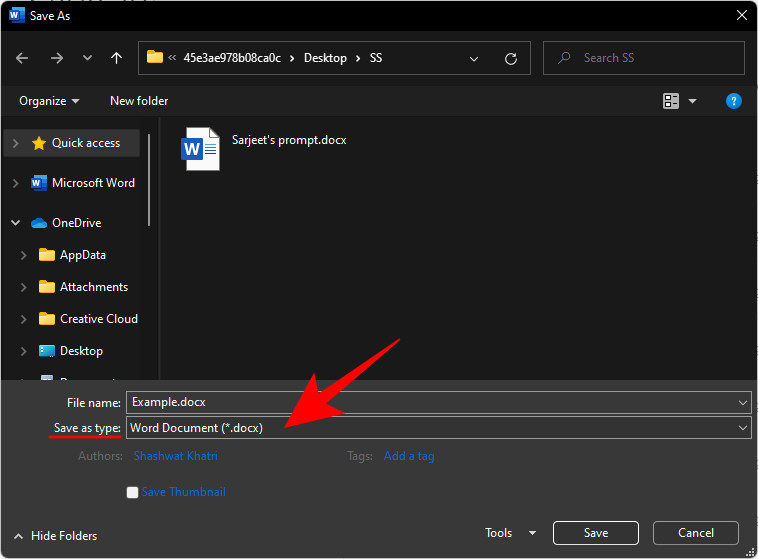
SFC Scan will find any potential problems and fix them for you.
Reboot in Safe Mode to identify the problem
Sometimes, corrupt third-party applications may be the cause of the problem. But to make sure this is the case, we have to reboot the PC in Safe Mode first. Here’s how to do so:
Press Start and click on the ‘Power’ button.

Then, while holding down the ‘Shift’ key, click on Restart.

Now, while the computer is restarting, you will be taken to the Advanced Restart options. Select Troubleshoot.
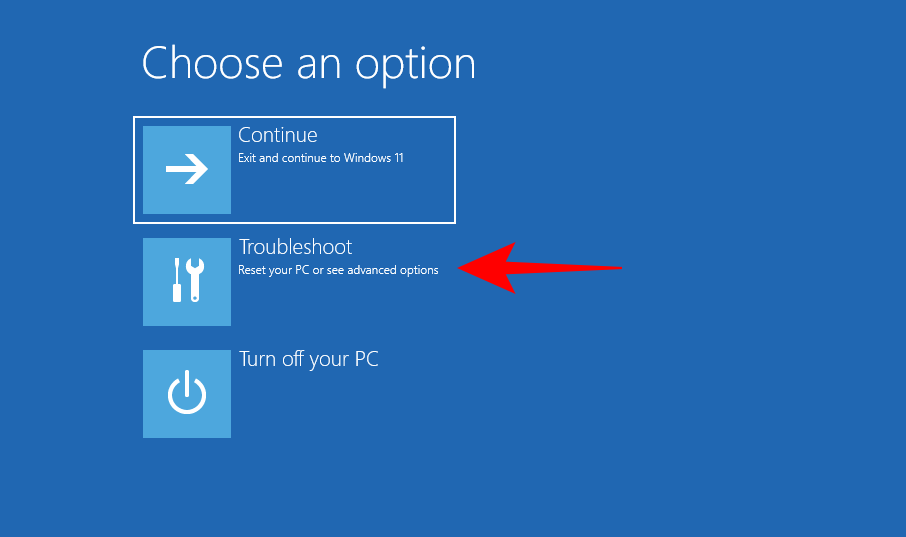
Click on Advanced options.
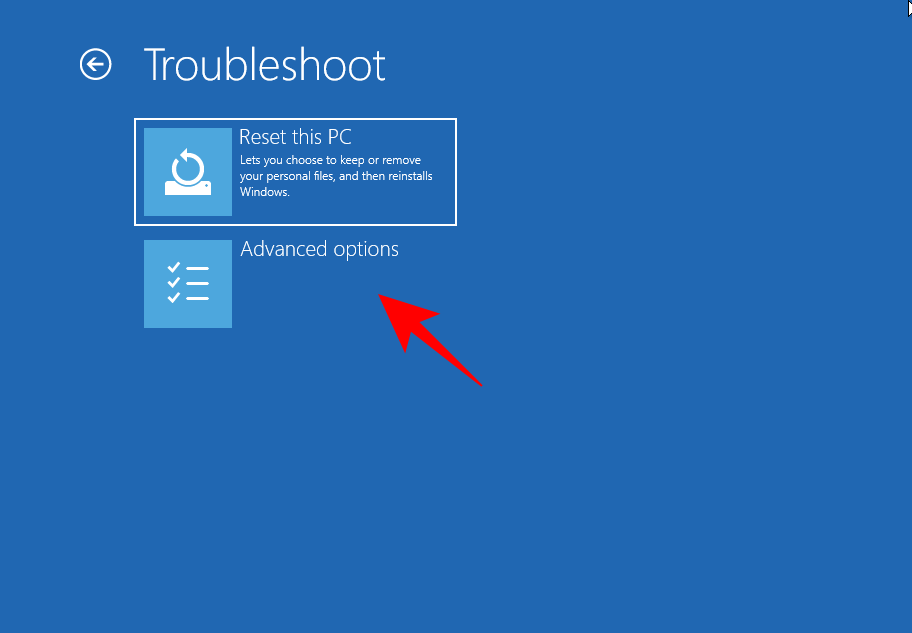
Click on Startup Settings.
Click Restart.
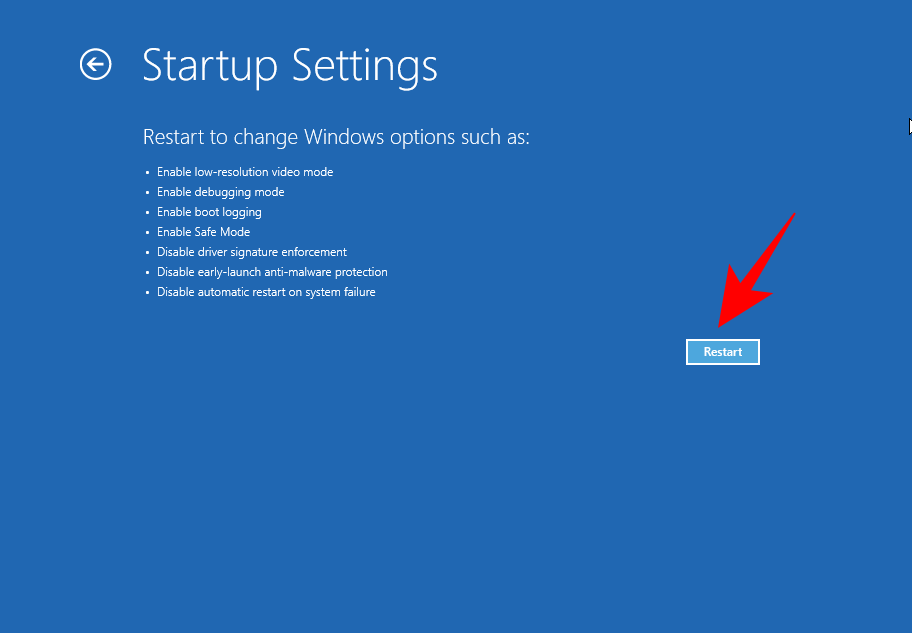
Now press the number that corresponds to Enable Safe Mode with Networking.
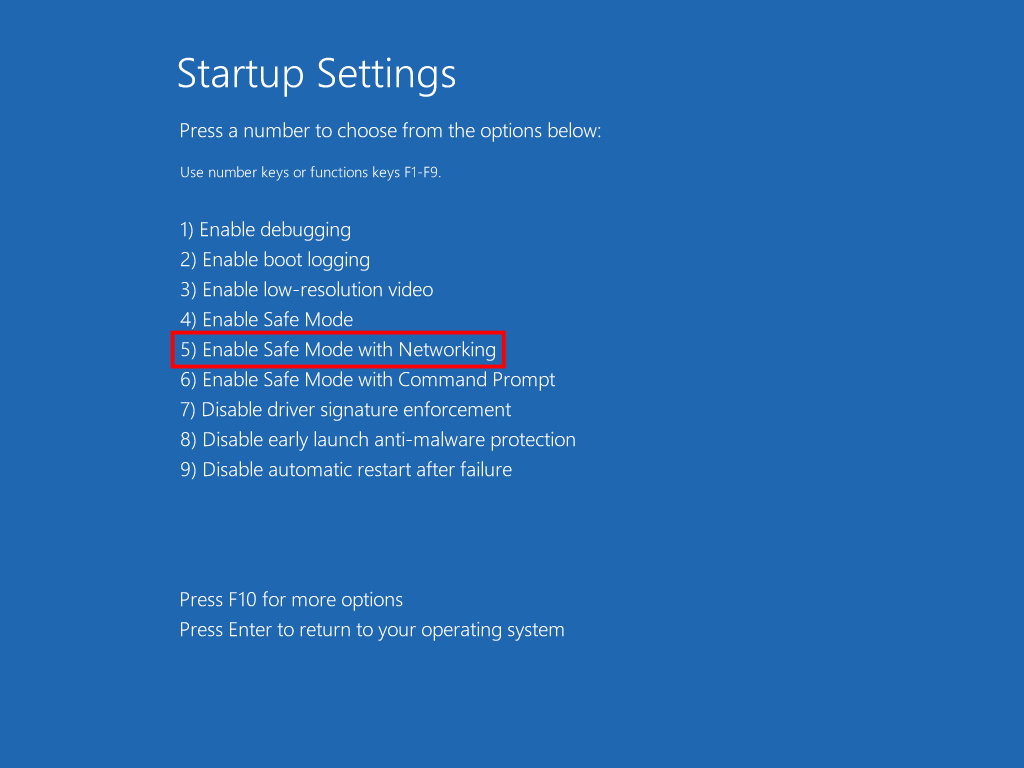
Check if the problem still persists in Safe Mode. If it does, here’s what you need to do.
Boot the computer back up normally, then press Start, type msconfig, and click on Run as administrator.
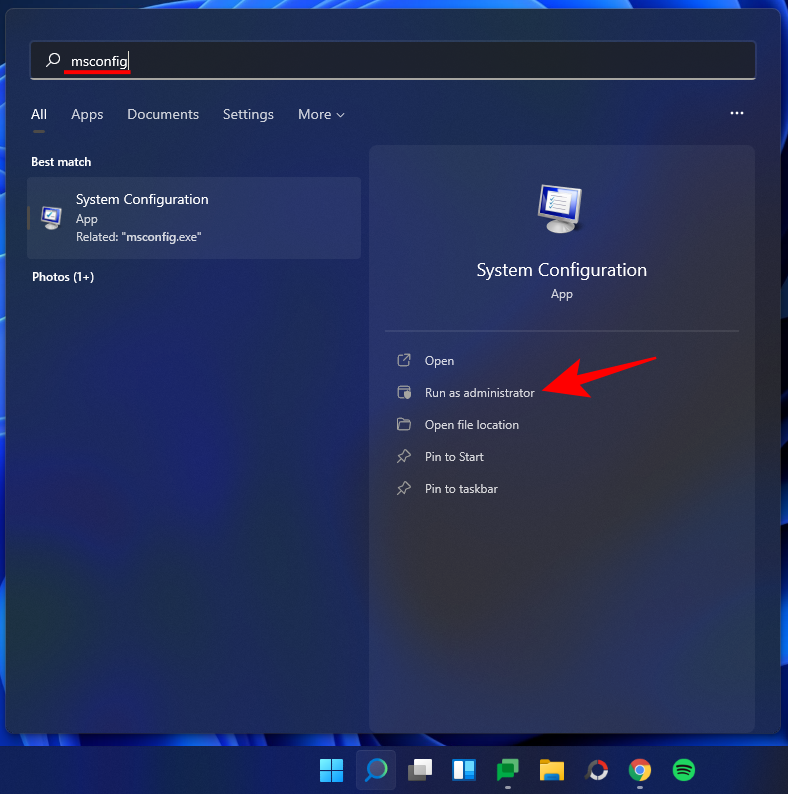
Under the ‘General’ tab, make sure to select Selective startup, but uncheck Load startup items.
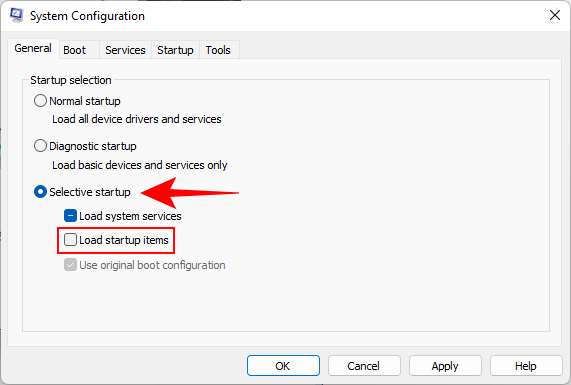
Then switch over to the ‘Services’ tab.
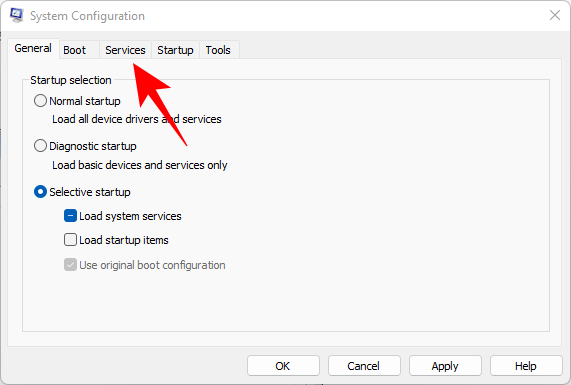
Here, click on Hide all Microsoft services at the bottom to select it. Then click Disable all.
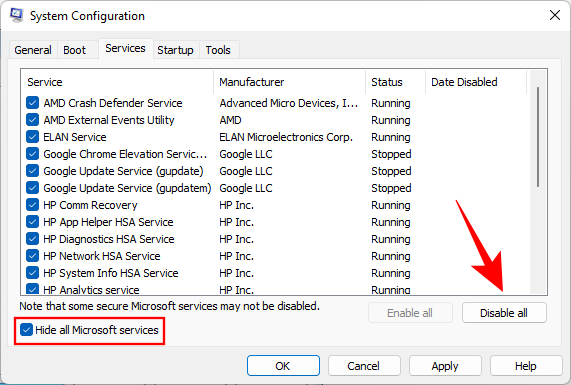
Click OK.
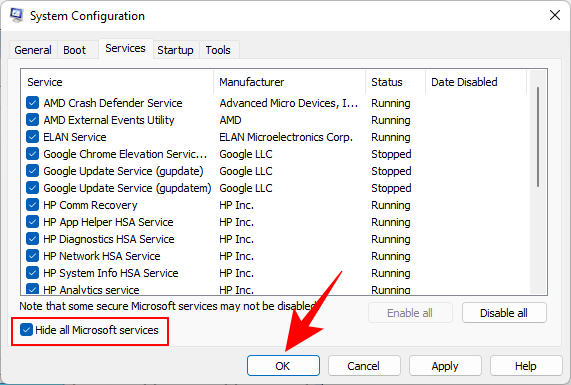
Restart your PC normally. If Windows Explorer is working fine, then the issue was caused most likely by a third-party app. You may need to hunt down exactly which program was interfering with the proper functioning of Windows Explorer.
We recommend uninstalling any recent apps that you may have installed around the time when this problem started to appear.
Scan for viruses
You should definitely run a full virus scan with your anti-virus program to find any viruses or malware lurking in your computer. Viruses come in various kinds and have the capacity to wreak havoc on your system, and a non-functioning Windows Explorer is one of the major symptoms.
Frequently Asked Questions (FAQs)
Windows Explorer is tied to a variety of visual elements that we as users interact with on a daily basis. It is only natural then to have questions about its functioning and what all you can do after you end or restart it. Here we answer a few commonly asked queries so you have all the information you need to make adjustments to Windows Explorer.
Is it safe to end Windows Explorer?
Yes, it is safe to end Windows Explorer. Doing so won’t lead to any problems. In fact, it may possibly fix the problems its elements may be experiencing. However, if you only end Windows Explorer without starting it up back again, you won’t have access to those very elements that have made Windows 11 stand out from its predecessors.
How often should I restart Windows Explorer?
Under normal circumstances, you won’t need to restart Windows Explorer at all. One of the main reasons why people restart Windows Explorer is when they’ve made changes to the registry the HKEY_CURRENT_USER registry key and need to see the changes implemented.
Other than that, Windows Explorer will require a soft reboot if one or more of its elements begin to malfunction. But if you’re constantly having to restart Windows Explorer, the problem may be found elsewhere. Refer to our fixes above to sort this issue.
Why does Windows Explorer keep crashing?
There are a few reasons why Windows Explorer may not be working as usual. But viruses within third-party applications downloaded from unknown or untrustworthy sources is one of the common cause for this. Windows Update too can introduce Explorer bugs with recent updates, especially if you’re on the Dev channel, although it’s not often the case.
Is any data lost when restarting Windows Explorer?
No, your data is not lost when you restart Windows Explorer. All your files and applications will return to the state in which they were when you restarted Windows Explorer. The only elements that are impacted are the UI elements that are dependent on Windows Explorer, such as the desktop, the Start Menu, File Explorer, and the taskbar.
Do copy paste keep working or get stopped?
Yes, the copy-paste function still keeps working when you end or restart Windows Explorer.
Can you reopen the same windows again after restarting Windows Explorer?
Yes, you can open the same windows again after restarting Windows Explorer. However, if you were using File Explorer to navigate through your drives and folders, you will have to open it up from the beginning and get to the folders you were accessing when you restarted Windows Explorer.
So these were the ways that you can restart Windows Explorer and when you should be doing so. We hope you now have a better understanding of the processes of Windows Explorer and the ways to manage them.
RELATED

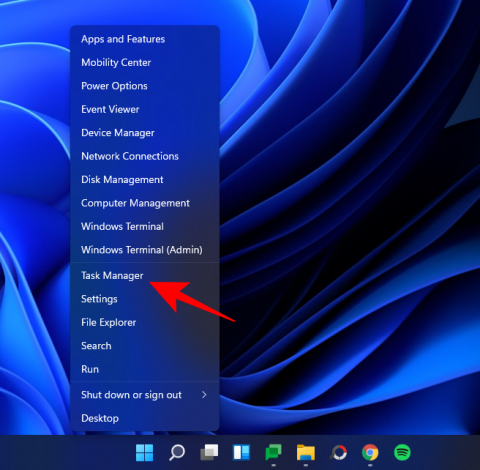













































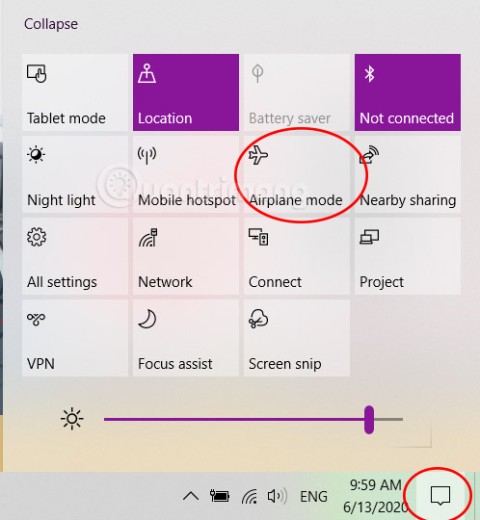
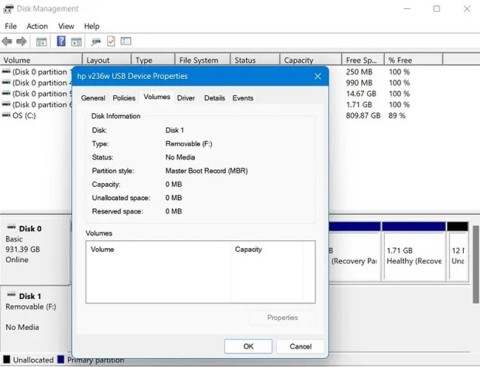
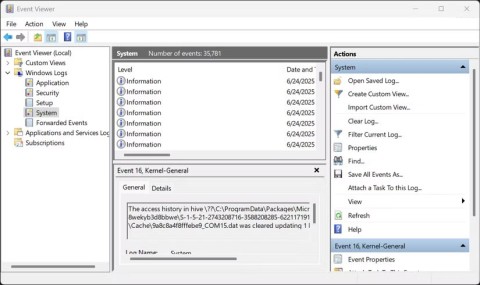
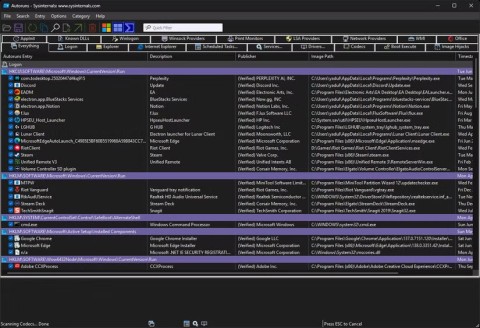
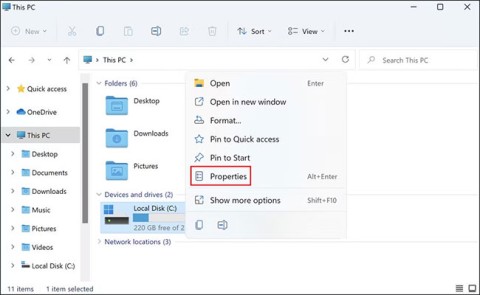

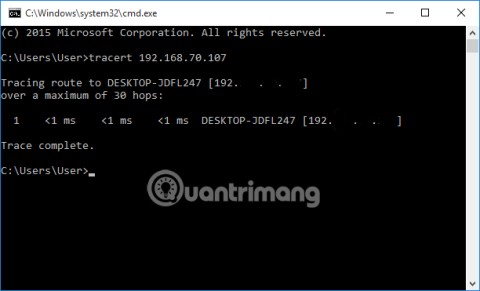
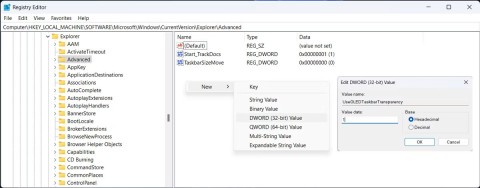
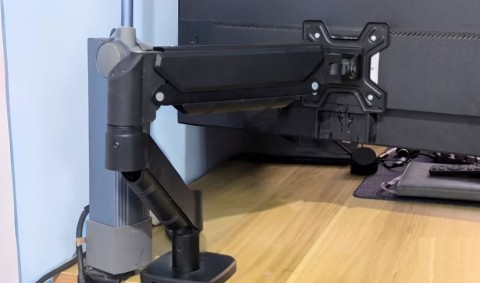
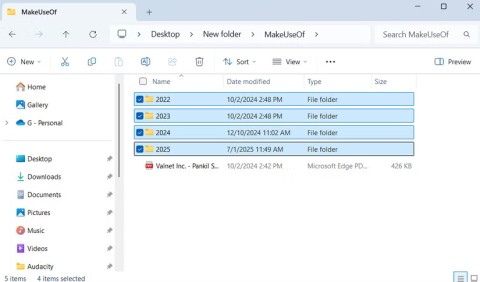
Hajnalka 123 -
Ez a megoldás valóban működik! A múlt héten kellett újraindítanom, és azóta sokkal gyorsabb a rendszerem
Virág Sz. -
Jó tudni, hogy van egy egyszerű megoldás a lassú Intézőre, de mi van, ha nem oldja meg a problémát? Van más javaslatotok?
Gulyás Miklós -
Nevessetek, de gyorsabban elindult a gépem miután újraindítottam az Intézőt, mint ahogy vártam! Igazán meglepő
Kovács Péter -
Szuper cikk, köszönöm! A Windows Intéző újraindítása tényleg segíthet, ha lassú a gép. Ti is tapasztaltatok már ilyet
Károly V. -
Az új Windows 11-nek sok előnye van, de néha mégis lassú. Az Intéző újraindítása valóban jó ötlet!
Dani 'geek' -
Kíváncsi vagyok, hogy más programok újraindításával is hasonló hatást érhetünk-e el. Találkoztatok már ilyen tapasztalattal?
Zsolt 1987 -
Néha a legapróbb megoldások a leghatékonyabbak. Ki gondolta volna, hogy az Intéző újraindítása ilyen hatalmas különbséget jelenthet
Luca D. -
Ez egy hasznos tanács! Én mindig újraindítom a gépemet, de az Intézőről megfeledkeztem. Most már tudom, hogy ezt is meg kell tenni
Fanny F. -
Az új Windows Intéző valóban megdöbbentően lassú lehet, de ez a trükk csodákat tett. Kösz, hogy megosztottad
Tibor D. -
Tudjátok, mi a legrosszabb? Amikor készülsz egy fontos munkára, és az Intéző megakad! De az újraindítás mindig segít!
Balázs 'techguru' -
Én mindig újraindítom az Intézőt, ha lassúnak érzem a gépem! Egy jó trükk, amit mindenkinek érdemes megpróbálnia
László A. -
Kíváncsi vagyok, mi történik, ha nem indul el az Intéző újraindítás után? Van valakinek tapasztalata ezzel
Csaba 'ccli' -
Ha nem tervezem alaposan, akkor nem tudom, mit tegyek. De jó, hogy van ez a megoldás, köszönöm
Rácz Gábor -
Olyan sokszor megcsináltam ezt a Windows 10-ben, de nem tudtam, hogy ez a Windows 11-nél is működik! Köszi a tippet
Németh Anna -
Láttam, hogy sokan kérdeztek arról, miért működik ez. Képzeljétek, az Intéző újraindítása frissíti a cache-t, ami segít a problémák megoldásában!
Emese K. -
Kösz, hogy felhívtad a figyelmem az Intéző újraindítására! Már régen nem csináltam, és azonnal észrevettem a változást
Szofi IT -
Jó írás, de szerintem a rendszer frissítése is elengedhetetlen a megfelelő működéshez. Ne felejtsétek el frissíteni a Windows-t sem
Mia Miau -
Vicces, de én sosem gondoltam volna, hogy az Intéző újraindítása ennyit számít. Megpróbálom a következő alkalommal!